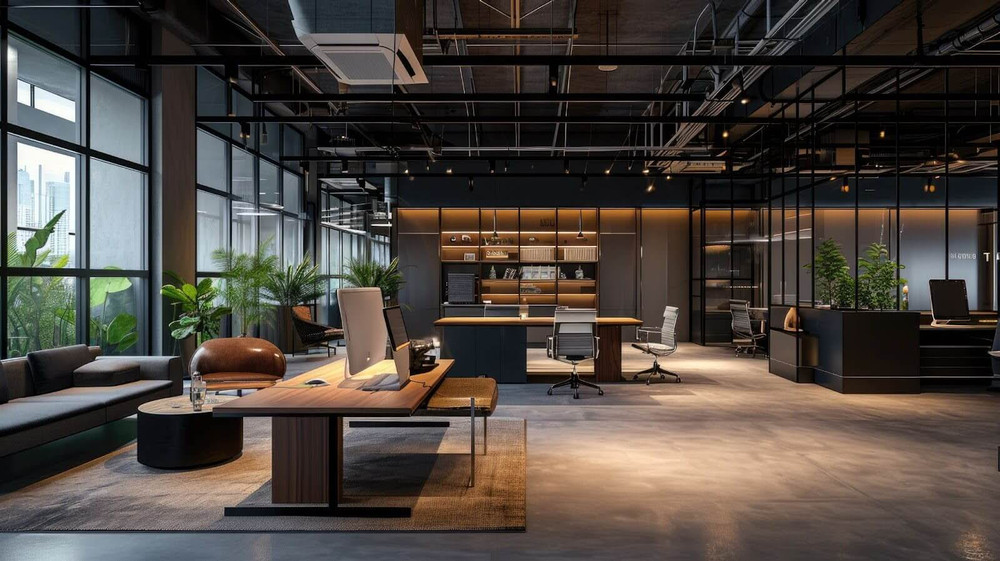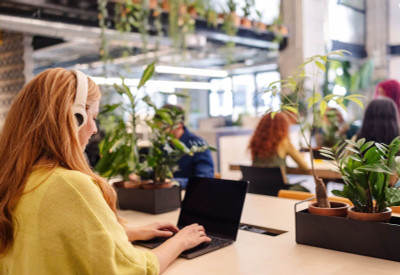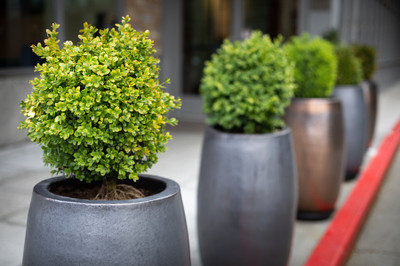Establishing Brand Identity Through Office Space Design
Posted by Jason Wyrwicz on May 8th 2025

A compelling company brand identity is a powerful tool that is often underutilized, especially in terms of office branding.
A brand identity includes all externally visible brand elements, starting with obvious elements like logos and typography and including additional areas like color, design choices, and even office space design.
Office interior branding and design may play a pivotal role in conveying company brand identity to employees, clients, customers, and partners who visit your office.
Whether your brand is bold, minimalistic, simple, or complex, your office’s design needs to reflect this identity.
Importance of Aligning Office Design with Brand Identity
Is corporate office branding truly an essential part of brand identity? Yes, it is. Let’s discuss some of the ways that office design impacts brand identity.
Employee Engagement
First, it can help to improve employee engagement and productivity. In many ways, employees value consistency, and consistent exposure to brand values and identity can foster a sense of unity and purpose among them.
Frequent contact with the company’s identity and values helps employees connect with their colleagues and employer. Overall, it’s good for morale and boosting productivity.
Building Client Trust and Improving Client Perception
One of the things that often leaves clients feeling unsure about a business, is when it has no fixed brand identity. This includes various aspects, ranging from communications received from a business to their office and interior branding.
The more consistently the brand identity is conveyed, the more secure clients feel and the better their perception of the business’s professionalism.

Attracting and Retaining Talent
Brands that demonstrate consistency and have a high-quality brand identity tend to attract more (and better) talent than their competitors. This is because this kind of investment in consistent branding and successfully conveying principles and intentions indicates that the business values its image and employees.
In short, consistent, high-quality brand identity correlates directly to the acquisition and retention of talented employees.
Key Elements of Office Space Design that Reflect Brand Identity
When trying to build a company brand identity and the corporate office branding to match, there are certain elements that will play a critical role. These include the following:
Color Palette
Your chosen color palette can have a significant impact on the overall effect of your brand identity, so remain consistent once you have chosen your brand colors. This includes all platforms, from printed and social media to office decor.

- Try to include some basic, neutral colors as part of your brand kit, allowing you to create consistency without a potentially overwhelming design style.
- Black and white are both relatively neutral colors that allow you to show off chosen accent colors to a much better effect.
- When overused, colors like bright yellow or hot pink quickly become overwhelming.
- Consistency is key. Once you’ve chosen your brand colors, remain faithful to them. This creates a sense of consistency while making your office space look like a cohesive whole rather than a confusing grouping of unrelated areas and concepts.
Layout and Space Configuration
When you’re creating your company’s brand identity and the interior office design that goes with it, it’s essential not to overlook the role that office layout can play.

- If your business takes privacy and personal space seriously, it’s well worth considering using large planters or other types of furniture to subdivide large spaces so that customers and employees have enough space.
- If your brand focuses strongly on collaboration and teamwork, ensure you have large spaces that allow for easy collaboration.
By using an appropriate layout, you can even emphasize some of your brand’s values. For instance, if your brand feels strongly about environmental issues and mental health, you can incorporate green walls and other elements that emphasize your approach to sustainability issues.
Furniture and Decor
Furniture and decor are also integral in the overall personality (or identity, if you will) of your office space. Accordingly, you should acquire furniture and decor that suits the general approach of your brand.

- For a modern, minimalistic brand, sleek, streamlined furniture and decor are ideal.
- In the case of a more comfortable, homely brand, the furniture could consist of comfortable couches, armchairs, and other items that match the aesthetics.
Lighting and Ambiance
Lighting is another valuable element and plays an irreplaceable role when it comes to setting the ambiance of your entire office space.

- For instance, in spaces like reception areas, bright, clear lighting often helps to create a professional atmosphere.\
- Warmer, more subdued lighting can make waiting areas seem more relaxed and even build a sense of trust.
Sensory Elements
Sensory elements are an essential part of modern design. Many modern office designs incorporate an array of different textures and shaped elements for visual effects, as well as a range of auditory stimuli to create a complete effect.
- As long as they're brand-relevant, you can easily include a wide range of different sensory stimuli.
- These range from posters and wallpapers to background music, podcasts, and even touchable elements like corkboards.
This approach will help to create a comprehensive and immersive branding experience for employees and clients who visit your office.
Greenery and Biophilic Design
Biophilic design is easily one of the most significant contributions that the 21st century has made in terms of architecture and interior design.

This approach has taken research and implemented it as a set of principles allowing landscape design and architecture design to incorporate elements that connect people to nature in their everyday lives.
- Through careful building design or the incorporation of elements like grow lights, it is possible to incorporate plants into the office and keep them healthy.
You may, however, ask yourself why you’d want to incorporate biophilic design. There are many potential benefits, including:
- improved air quality,
- better mental health,
- greater focus from employees,
- as well as the obvious environmental benefits of carbon sequestration and reducing your overall carbon footprint.
In short, biophilic design declares that your brand is interested in its clients, its employees, and taking care of the environment.
- Thanks to the introduction of fibreglass planters, which have the strength of concrete, but the lightweight consistency of something like plastic, it is a lot easier to arrange (and rearrange) planters and greenery to your liking.

The options are nearly limitless, when using fiberglass planters. From a diverse array of shapes and colors, to the lightness needed for building green walls and vertical gardens, you can easily create any shape or design that you can imagine.
Steps to Implement Brand Identity into Office Design
When implementing your chosen brand identity and office design, a measured approach will help you achieve the best results with the minimum investment of time and effort. Below, we’ll discuss these steps in detail.
Assess Your Brand Values and Culture
First, you need to assess your brand’s core principles. Document them in as much detail as you can, so that you can incorporate them into your office design as well as you possibly can. This should include everything from the broadest to the most specific aspects.
Consider things like:
- your brand’s stance on environmental and social issues,
- your ethical beliefs in terms of dealing with clients and employees,
- and any other issues on which your company has firm beliefs.
Collaborate with Design Professionals
Next, you need to translate these standings and beliefs into something concrete: a design plan. We advise working with a design professional since they have both the experience and knowledge required to convert vague concepts into a concrete design plan.
They’ll also help you implement the design in a non-invasive and orderly fashion.
Incorporate Employee Feedback
After your initial talks with a design professional, it’s time to get input from your employees. After all, they’re the people who will be working in this environment daily.
Encourage them to give you input on all aspects of the design plan, and they’ll help you see where alternatives might be more practical or where you can improve to help foster a positive brand culture.
Pilot Testing and Feedback Loop
At this point, you’re ready to start implementing your design concepts. We recommend implementing the new design in phases so that you can easily discern any problems during this phase.
It’s also important to remain open to feedback so that your design, and the outward demonstration of your brand’s identity, can continuously improve.

Challenges and Considerations
As with anything, when you’re trying to design office interior branding that builds your overall brand identity, you will face challenges. You’ll also need to consider many different aspects and decide how they play into your overall plan. Below, we’ll discuss some of these in detail and make suggestions about how to handle them.
Budget Constraints
Budgetary constraints are one of the most significant challenges that many businesses face. Fortunately, corporate office branding and corporate brand identity design don’t have to be as expensive as people think. Here are some ways to make your budget work for you.
- Prioritize key areas: A small budget can mean that it’s best to start with areas where clients and employees spend their time. You may expand your design to include other areas later on.
- Consider repurposing old items: Buying decorative elements second-hand (or refurbished) rather than new can reduce costs.
- Keep your design simple at first: While you may have an ambitious long-term design plan, simplicity will allow you to work within the constraints of your current budget.
- Try to invest wisely, not just cheaply: As an example, if you buy a plastic planter, you will need to replace it in a few months or years. A fiberglass planter will be more expensive initially, but has a lifespan that rivals your own, meaning you’ll be paying less in the long term. Buy quality items less often, rather than many low-quality items quickly.
Evolving Brand Identity
Many brands build for permanence, which is admirable, but fail to account for a brand that grows and changes over time. Try to avoid this mistake when planning your own design by making it as fluid as possible, so it may evolve with the brand.
Some ways to do this include the use of modular furniture, obtaining wall hangings and decor that can be repurposed when they outlive their purpose in a specific area, and even using temporary walls.
Not only can these temporary walls become branding canvases, but you can move and remove them as needed, giving your brand room to grow.
Employee Diversity
For many brands, diversity, and inclusivity are key features. They can add an additional layer of consideration to your design plan.
When trying to incorporate these aspects, you should aim to do things like incorporating wheelchair-friendly walkways and bathrooms, as well as avoiding textures, colors, and patterns that may act as triggers for neurodivergent individuals.
It’s also a good idea to incorporate areas where people can go for privacy and quiet to improve mental health and keep individuals calm and relaxed.
Conclusion
In your office, interior branding can be a keystone in building your overall brand identity successfully. Yet, it is often one of the most overlooked elements of this essential business function.
From color palette to furniture choices and even the introduction of commercial planters that serve to highlight your chosen design structure, brand-appropriate office design has many significant advantages.
One tremendous tool for accomplishing that perfectly polished brand identity and office design is a well-chosen planter. Considering that they’re fully brandable and available in a nearly limitless array of colors and shapes, they’re the ideal tool in the designer’s arsenal.



